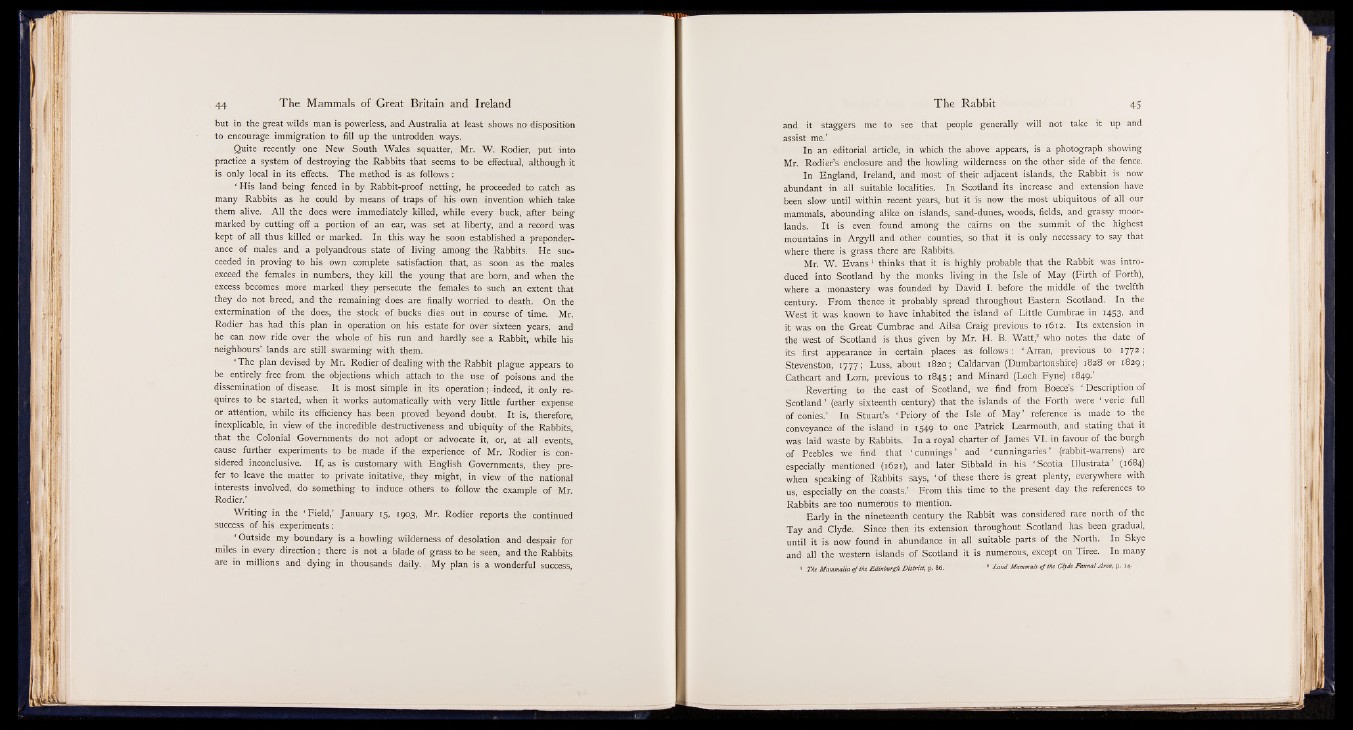
but in the great wilds man is powerless, and Australia at least shows no disposition
to encourage immigration to fill up the untrodden ways.
Quite recently one New South Wales squatter, Mr. W. Rodier, put into
practice a system of destroying the Rabbits that seems to be effectual, although it
is only local in its effects. The method is as follows :
‘ His land being fenced in by Rabbit-proof netting, he proceeded to catch as
many Rabbits as he could by means of traps of his own invention which take
them alive. All the does were immediately killed, while every buck, after being
marked by cutting off a portion of an ear, was set at liberty, and a record was
kept of all thus killed or marked. In this way he soon established a preponderance
of males and a polyandrous state of living among the Rabbits. He succeeded
in proving to his own complete satisfaction that, as soon as the males
exceed the females in numbers, they kill the young that are born, and when the
excess becomes more marked they persecute the females to such an extent that
they do not breed, and the remaining does are finally worried to death. On the
extermination of the does, the stock of bucks dies out in course of time. Mr.
Rodier has had this plan in operation on his estate for over sixteen years, and
he can now ride over the whole of his run and hardly see a Rabbit, while his
neighbours’ lands are still swarming with them.
‘ The plan devised by Mr. Rodier of dealing with the Rabbit plague appears to
be entirely free from the objections which attach to the use of poisons and the
dissemination of disease. It is most simple in its operation; indeed, it only requires
to be started, when it works automatically with very little further expense
or attention, while its efficiency has been proved beyond doubt. It is, therefore,
inexplicable, in view of the incredible destructiveness and ubiquity of the Rabbits,
that the Colonial Governments do not adopt or advocate it, or, at all events,
cause further experiments to be made if the experience of Mr. Rodier is considered
inconclusive. If, as is customary with English Governments, they prefer
to leave the matter to private initative, they might, in view of the national
interests involved, do something to induce others to follow the example of Mr.
Rodier.’
Writing in the ‘ Field,’ January 15, 1903, Mr. Rodier reports the continued
success of his experiments:
'Outside my boundary is a howling wilderness of desolation and despair for
miles in every direction; there is not a blade of grass to be seen, and the Rabbits
are in millions and dying in thousands daily. > My plan is a wonderful success,
and it staggers me to see that people generally will not take it up and
assist me.’
In an editorial article, in which the above appears, is a photograph showing
Mr. Rodier’s enclosure and the howling wilderness on the other side of the fence.
In England, Ireland, and most of their adjacent islands, the Rabbit is now
abundant in all suitable localities; In Scotland its increase and extension have
been slow until within recent years, but it is now the most ubiquitous of all our
mammals, abounding alike on islands, sand-dunes, woods, fields; and grassy moorlands.
It is even found among the cairns on the summit of the highest
mountains in Argyll and other countiek*) so that it is only necessary to say that
where there is. grass there are Rabbits.
Mr. W. Evans1 thinks that it Is' highly probable that the Rabbit was introduced
into Scotland by the monks living in the-Isle of May (Firth of Forth),
where a monastery was founded by David I. before the middl^lpf the twelfth
century. From thence it probably spread throughout Eastern Scotland. In the
West it was known to have inhabited the island of Little Cumbrae in 1453. and
it was on the Great Cumbrae and Ailsa Craig previous to 1612. Its extension in
the west of Scotland , is thus given by Mr. H. B. Watt,s who notes the date of
its first appearance in certain places as follows: ‘ Arran, previous to 1772 I
Stevenston, 1777; Luss, about 1820; Caldarvan (Dumbartonshire) 1828 or 1829;
Cathcart and Lorn, previous to 1845; and Minard (Loch Fyne) 1849/
Reverting to the east of Scotland, we find from Boece’^f|t Description of
Scotland ’ (early sixteenth century) that the islands of the Forth were ‘ verie full
o f conies,’ In Stuart's ‘ Priory of the Isldeof May’ reference made to the
conveyanil| of the island* in 1549 to one Patrick Learmouth, and stating that it
was laid waste by Rabbits'. In a royal charter of James VI. in favour of the burgh
of Peebles we find that ‘ cunnings’ and ‘ cunningaric®! (rabbit-warrens) are
especially mentioned (1621), and later Sibbald in his ‘ Scotia Iliustrata (1684)
when speaking of Rabbits says, ‘ of these there is great plenty, everywhere with
us, especially on the coasts.’ From this time to the present day the references to
Rabbits are too numerous to mention.
Early in the nineteenth century the Rabbit was considered rare north of the
Tay and Clyde. Since then its extension throughout Scotland has been gradual,
Until it is now found in abundance in all suitable parts of the North. In Skye
and all the western islands of Scotland it is numerous, except on Time. In many
* Land Mammals o f the Clyde The Mammalia o f the Edinburgh District, p. 86. Faunal Area, p. 14.